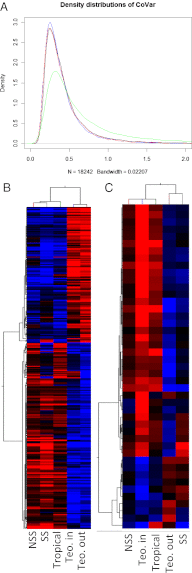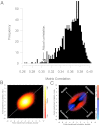Reshaping of the maize transcriptome by domestication
- PMID: 22753482
- PMCID: PMC3406829
- DOI: 10.1073/pnas.1201961109
Reshaping of the maize transcriptome by domestication
Abstract
Through domestication, humans have substantially altered the morphology of Zea mays ssp. parviglumis (teosinte) into the currently recognizable maize. This system serves as a model for studying adaptation, genome evolution, and the genetics and evolution of complex traits. To examine how domestication has reshaped the transcriptome of maize seedlings, we used expression profiling of 18,242 genes for 38 diverse maize genotypes and 24 teosinte genotypes. We detected evidence for more than 600 genes having significantly different expression levels in maize compared with teosinte. Moreover, more than 1,100 genes showed significantly altered coexpression profiles, reflective of substantial rewiring of the transcriptome since domestication. The genes with altered expression show a significant enrichment for genes previously identified through population genetic analyses as likely targets of selection during maize domestication and improvement; 46 genes previously identified as putative targets of selection also exhibit altered expression levels and coexpression relationships. We also identified 45 genes with altered, primarily higher, expression in inbred relative to outcrossed teosinte. These genes are enriched for functions related to biotic stress and may reflect responses to the effects of inbreeding. This study not only documents alterations in the maize transcriptome following domestication, identifying several genes that may have contributed to the evolution of maize, but highlights the complementary information that can be gained by combining gene expression with population genetic analyses.
Conflict of interest statement
The authors declare no conflict of interest.
Figures



Similar articles
-
A conserved genetic architecture among populations of the maize progenitor, teosinte, was radically altered by domestication.Proc Natl Acad Sci U S A. 2021 Oct 26;118(43):e2112970118. doi: 10.1073/pnas.2112970118. Proc Natl Acad Sci U S A. 2021. PMID: 34686607 Free PMC article.
-
Population genomics of Zea species identifies selection signatures during maize domestication and adaptation.BMC Plant Biol. 2022 Feb 18;22(1):72. doi: 10.1186/s12870-022-03427-w. BMC Plant Biol. 2022. PMID: 35180846 Free PMC article.
-
The potential role of genetic assimilation during maize domestication.PLoS One. 2017 Sep 8;12(9):e0184202. doi: 10.1371/journal.pone.0184202. eCollection 2017. PLoS One. 2017. PMID: 28886108 Free PMC article.
-
Genetic, evolutionary and plant breeding insights from the domestication of maize.Elife. 2015 Mar 25;4:e05861. doi: 10.7554/eLife.05861. Elife. 2015. PMID: 25807085 Free PMC article. Review.
-
Maize domestication and gene interaction.New Phytol. 2018 Oct;220(2):395-408. doi: 10.1111/nph.15350. Epub 2018 Jul 23. New Phytol. 2018. PMID: 30035321 Review.
Cited by
-
Evolutionary Metabolomics Reveals Domestication-Associated Changes in Tetraploid Wheat Kernels.Mol Biol Evol. 2016 Jul;33(7):1740-53. doi: 10.1093/molbev/msw050. Epub 2016 Apr 5. Mol Biol Evol. 2016. PMID: 27189559 Free PMC article.
-
Transcriptome profiling of wheat glumes in wild emmer, hulled landraces and modern cultivars.BMC Genomics. 2015 Oct 13;16:777. doi: 10.1186/s12864-015-1996-0. BMC Genomics. 2015. PMID: 26462652 Free PMC article.
-
Transcriptomic comparison reveals genetic variation potentially underlying seed developmental evolution of soybeans.J Exp Bot. 2018 Oct 12;69(21):5089-5104. doi: 10.1093/jxb/ery291. J Exp Bot. 2018. PMID: 30113693 Free PMC article.
-
Integrating Coexpression Networks with GWAS to Prioritize Causal Genes in Maize.Plant Cell. 2018 Dec;30(12):2922-2942. doi: 10.1105/tpc.18.00299. Epub 2018 Nov 9. Plant Cell. 2018. PMID: 30413654 Free PMC article.
-
Independent domestication events in the blue-cheese fungus Penicillium roqueforti.Mol Ecol. 2020 Jul;29(14):2639-2660. doi: 10.1111/mec.15359. Epub 2020 Feb 3. Mol Ecol. 2020. PMID: 31960565 Free PMC article.
References
-
- Doebley J. The genetics of maize evolution. Annu Rev Genet. 2004;38:37–59. - PubMed
-
- Doebley JF, Gaut BS, Smith BD. The molecular genetics of crop domestication. Cell. 2006;127:1309–1321. - PubMed
-
- Freeling M. Bias in plant gene content following different sorts of duplication: Tandem, whole-genome, segmental, or by transposition. Annu Rev Plant Biol. 2009;60:433–453. - PubMed
Publication types
MeSH terms
Associated data
- Actions
LinkOut - more resources
Full Text Sources
Molecular Biology Databases

